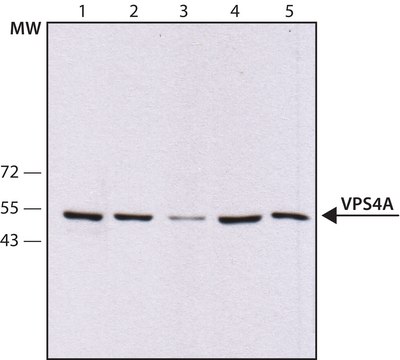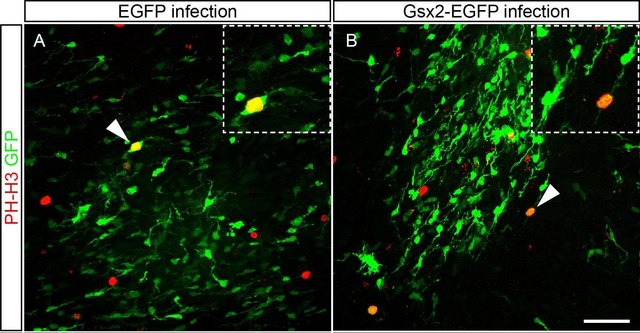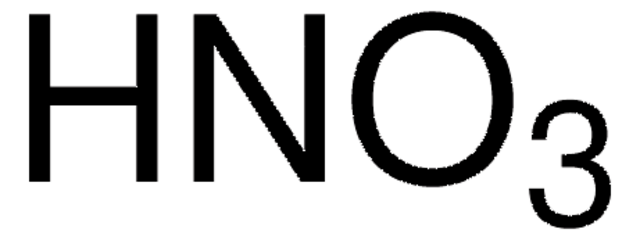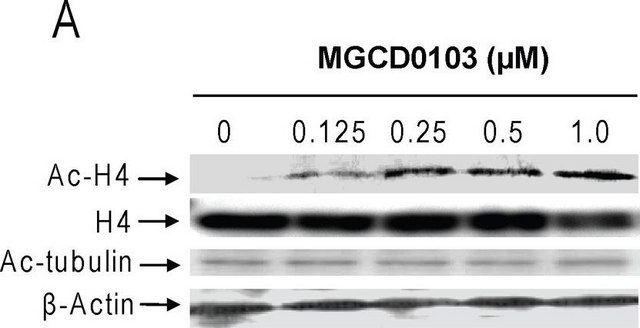推荐产品
生物来源
rabbit
质量水平
抗体形式
serum
抗体产品类型
primary antibodies
克隆
polyclonal
种属反应性
human, mouse
技术
immunocytochemistry: suitable
immunoprecipitation (IP): suitable
western blot: suitable
NCBI登记号
UniProt登记号
运输
ambient
靶向翻译后修饰
unmodified
基因信息
human ... VPS4A(27183)
mouse ... Vps4A(116733)
一般描述
Vacuolar protein sorting-associated protein 4A (EC 3.6.4.6; UniProt Q9UN37; also known as hVPS4, Protein SKD2, SKD1-homolog, Vacuolar protein sorting factor 4A, Vacuolar sorting protein 4, VPS4A) is encoded by the VPS4A (also known as SKD1A, VPS4, VPS4-1) gene (Gene ID 27183) in human. VPS4A is a member of the ATPases associated with various cellular activities (AAA) family proteins. The ESCRT (endosomal sorting complexes required for transport) machinery consists of five complexes (SCRT-0, ESCRT-I, ESCRT-II, ESCRT-III, and Vps4) and mediates multiple cellular membrane remodeling events, ranging from multivesicular bodies and exosomes formation to the final membrane abscission stage of cytokinesis, all of which converge in the scission of the narrow membrane neck that connects bud to parent membrane or daughter cell to daughter cell. Scission depends on the polymerization of soluble ESCRT-III monomers or dimers into tightly membrane-bound filaments. VPS4A is essential for the functions of the ESCRTs in cells by mediating the disassembly of ESCRT-III filaments to ensure a constant replenish of the pool of soluble ESCRT-III monomers. The ESCRTs are also exploited by HIV-1 and many other enveloped viruses for their escape from the host cells. In addition, VPS4A is reported to facilitate the secretion of oncogenic miRNAs in exosomes and downregulation of VPS4A in hepatocellular carcinoma (HCC) is associated with tumor progression and metastasis.
特异性
VPS4A immunostaining and target band detection by UT289 was observed only in untransfected, but not VPS4A shRNA-transfected HeLa cells (Morita, E., et al. (2010). Proc. Natl. Acad. Sci. U.S.A. 107(29):12889-12894). Due to a typographical error, UT289 was listed as UT829 in Table S1 of Skalicky, J.J., et al. (2012). J. Biol. Chem. 287(52):43910-43926.
免疫原
Recombinant human VPS4A lacking N-terminal MIT domain (Morita, E., et al. (2010). Proc. Natl. Acad. Sci. U.S.A. 107(29):12889-12894).
应用
Detect Vacuolar protein sorting-associated protein 4A using this rabbit polyclonal Anti-VPS4A (UT289), Cat. No. ABS1646, validated for use in Immunocytochemistry, Immunoprecipitation, and Western Blotting.
Immunocytochemistry Analysis: A representative lot detected VPS4A immunoreactivity concentrated at the spindle pole during metaphase and at the midbody during cytokinesis in 3% paraformaldehyde-fixed HeLa cells. No staining was seen in VPS4A shRNA-transfected HeLa cells (Morita, E., et al. (2010). Proc. Natl. Acad. Sci. U.S.A. 107(29):12889-12894).
Immunoprecipitation Analysis: A representative lot immunoprecipited EGFP-VPS4A fusion together with CHMP5-Myc and Myc-LIP5 exogenously expressed in HEK293T cells. CHMP5-Myc with L4D mutation and Myc-LIP5 with M64A, W147D, or Y278A mutation failed to co-immunoprecipitate with VPS4A (Skalicky, J.J., et al. (2012). J. Biol. Chem. 287(52):43910-43926).
Western Blotting Analysis: A representative lot detected both endogenous VPS4A and exogenously expressed EGFP-VPS4A fusion in HEK293T cell lysates as well as in Anti-Myc immunoprecipites from CHMP5-Myc or Myc-LIP5 expressing cells (Skalicky, J.J., et al. (2012). J. Biol. Chem. 287(52):43910-43926).
Western Blotting Analysis: A representative lot detected the VPS4A target band in lysate from untransfected, but not VPS4A shRNA-transfected, HeLa cells (Morita, E., et al. (2010). Proc. Natl. Acad. Sci. U.S.A. 107(29):12889-12894).
Immunoprecipitation Analysis: A representative lot immunoprecipited EGFP-VPS4A fusion together with CHMP5-Myc and Myc-LIP5 exogenously expressed in HEK293T cells. CHMP5-Myc with L4D mutation and Myc-LIP5 with M64A, W147D, or Y278A mutation failed to co-immunoprecipitate with VPS4A (Skalicky, J.J., et al. (2012). J. Biol. Chem. 287(52):43910-43926).
Western Blotting Analysis: A representative lot detected both endogenous VPS4A and exogenously expressed EGFP-VPS4A fusion in HEK293T cell lysates as well as in Anti-Myc immunoprecipites from CHMP5-Myc or Myc-LIP5 expressing cells (Skalicky, J.J., et al. (2012). J. Biol. Chem. 287(52):43910-43926).
Western Blotting Analysis: A representative lot detected the VPS4A target band in lysate from untransfected, but not VPS4A shRNA-transfected, HeLa cells (Morita, E., et al. (2010). Proc. Natl. Acad. Sci. U.S.A. 107(29):12889-12894).
Research Category
Signaling
Signaling
质量
Evaluated by Western Blotting in MCF-7 cell lysate.
Western Blotting Analysis: A 1:1,000 dilution of this antiserum detected VPS4A in 10 µg of MCF-7 cell lysate.
Western Blotting Analysis: A 1:1,000 dilution of this antiserum detected VPS4A in 10 µg of MCF-7 cell lysate.
目标描述
~52 kDa observed. 48.90/48.91 kDa (human/mouse) calculated. Uncharacterized bands may be observed in some lysate(s).
外形
Unpurified.
Rabbit polyclonal antibody serum with 0.05% sodium azide.
储存及稳定性
Stable for 1 year at -20°C from date of receipt.
Handling Recommendations: Upon receipt and prior to removing the cap, centrifuge the vial and gently mix the solution. Aliquot into microcentrifuge tubes and store at -20°C. Avoid repeated freeze/thaw cycles, which may damage IgG and affect product performance.
Handling Recommendations: Upon receipt and prior to removing the cap, centrifuge the vial and gently mix the solution. Aliquot into microcentrifuge tubes and store at -20°C. Avoid repeated freeze/thaw cycles, which may damage IgG and affect product performance.
其他说明
Concentration: Please refer to lot specific datasheet.
免责声明
Unless otherwise stated in our catalog or other company documentation accompanying the product(s), our products are intended for research use only and are not to be used for any other purpose, which includes but is not limited to, unauthorized commercial uses, in vitro diagnostic uses, ex vivo or in vivo therapeutic uses or any type of consumption or application to humans or animals.
未找到合适的产品?
试试我们的产品选型工具.
储存分类代码
12 - Non Combustible Liquids
WGK
WGK 1
法规信息
新产品
Lin Deng et al.
Journal of virology, 96(6), e0181121-e0181121 (2022-01-20)
We previously reported that hepatitis C virus (HCV) infection activates the reactive oxygen species (ROS)/c-Jun N-terminal kinase (JNK) signaling pathway. However, the roles of ROS/JNK activation in the HCV life cycle remain unclear. We sought to identify a novel role
我们的科学家团队拥有各种研究领域经验,包括生命科学、材料科学、化学合成、色谱、分析及许多其他领域.
联系技术服务部门





